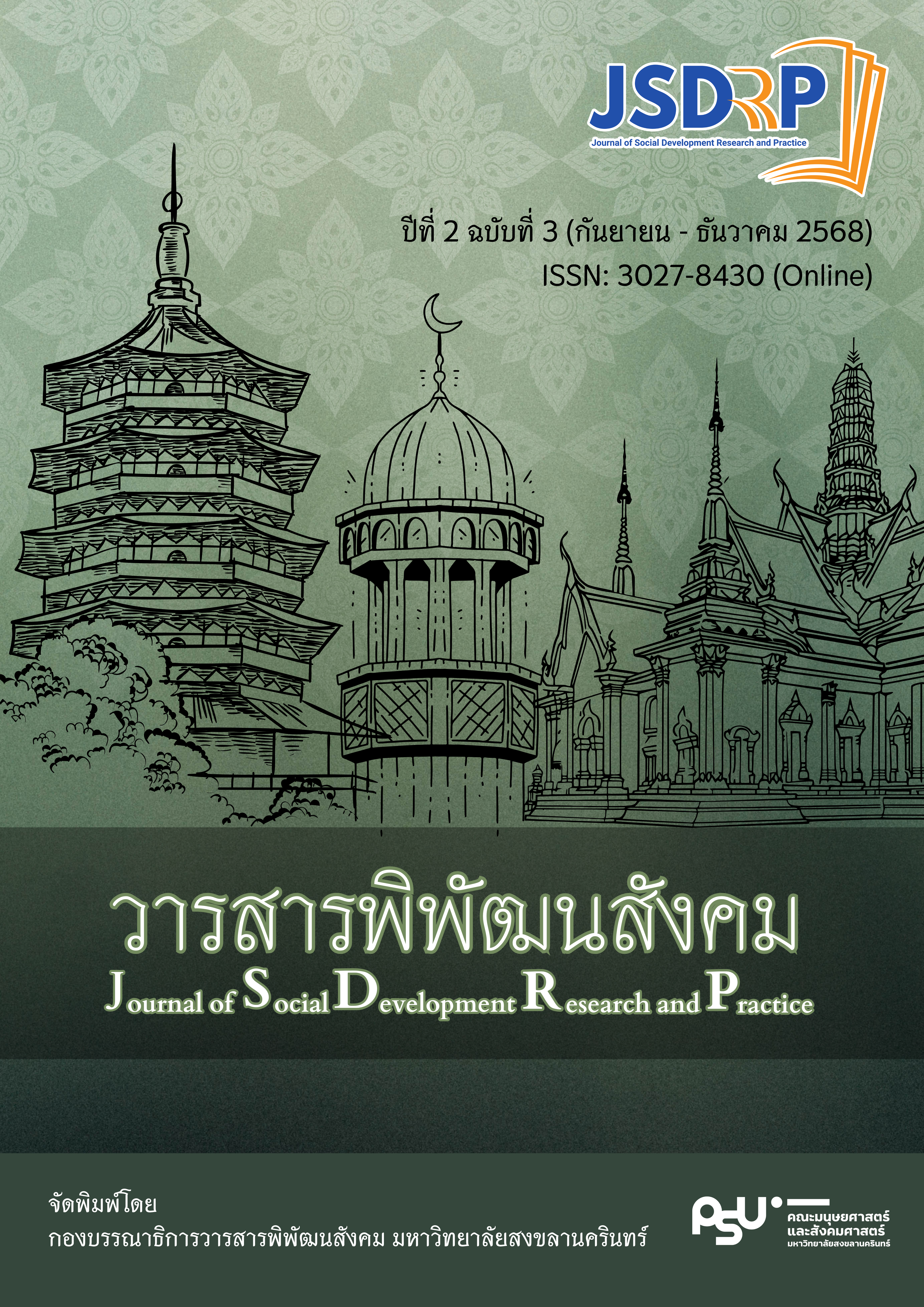Ram Tang Khae: Beliefs and Rituals of Manohra Case Study: Nora Phan S. Charoensin, Ban Ko Yee, Khok Saba Subdistrict, Na Yong District, Trang Province.
Keywords:
Beliefs, Rituals, Ram Tang Khae, Conservation guidelines, ManohraAbstract
Purpose: (1) To study the beliefs and rituals of the Ram Tang Khae, Ban Koh Yi, Khok Saba Subdistrict, Na Yong District, Trang Province, and (2) To study the guidelines for preserving the Ram Tang Khae rituals.
Methodology: This is qualitative research using observation and in-depth interviews with key informants as follows: 1) the owner of the Manora troupe of 1 person, specifically selected because he is a person with knowledge and ability in information, beliefs and rituals related to the Ram Tang Khae, Nora Phan S. Charoensin. 2) the Nora performers of 3 people, specifically selected because they are knowledgeable and skilled in the Ram Tang Khae, Nora Phan S. Charoensin. 3) the musicians of 2 people, specifically selected because they are knowledgeable and skilled in the music in the Ram Tang Khae ritual, Nora Phan S. Charoensin. 4) the hosts of 1 person, specifically selected because they believe in the Ram Tang Khae ritual, Nora Phan S. Charoensin. 5) the audience of 2 people, specifically selected because they are interested in and have knowledge and understanding of the Ram Tang Khae ritual, Nora Phan S. Charoensin. Data were analyzed by interpreting the meaning from thematic analysis. The results of the analysis of data on the Ram Tang Khae : a case study of beliefs and rituals in Khok Saba Subdistrict, Na Yong District, Trang Province, by presenting the main points from the interviews and summarizing the important factors and presenting them through descriptive analysis.
Findings: The Nora Rong Krua dance is a performance based on the belief that the fate of crocodiles is left in the role of a golden crowbar. Using a spear to stab a replica of a crocodile made of banana Tani to show off its acting skills and expel all its charm. It is a sacred ritual linked to the beliefs and lifestyle of the southern people.
Applications of this study: Using knowledge related to the beliefs of the Ram Tang Khe ritual as a guideline fr preserving the Ram Tang Khe ritual as that it does not disappear.
References
กรมส่งเสริมวัฒนธรรม. (2563). โนรา: ศิลปะการร้อง รำ ที่ผูกผันกับชีวิต. สืบค้นเมื่อ 21 มีนาคม 2568, จาก https://qrcode.culture.go.th/pdfbook/Nora%20a%20Living%20Dance%20Tradition%20of%20Southern%20Thailand.pdf
ธวัช ปุณโณทก. (2538). วัฒนธรรมพื้นบ้าน: คติความเชื่อ ความเชื่อพื้นบ้านอันสัมพันธ์กับวิถี. พิมพ์ครั้งที่ 4. กรุงเทพฯ: จุฬาลงกรณ์มหาวิทยาลัย.
ประโรม กุ่ยสาคร. (2547). การพัฒนาแบบฝึกเสริมทักษะ เรื่อง การคูณการหารโดยการบูรณาการภูมิปัญญาท้องถิ่นสำหรับนักเรียนชั้นประถมศึกษาปีที่ 5 (วิทยานิพนธ์ปริญญาศึกษาศาสตรมหาบัณฑิต สาขาวิชาหลักสูตรและการนิเทศ). นครปฐม: มหาวิทยาลัยศิลปากร.
สายฝน ไฝเส้ง. (2557). การใช้อาวุธในการรำโนราประกอบพิธีกรรม. วารสารศิลปะและวัฒนธรรมแห่งเอเชีย, 14(1), 99-110.
สุนันทา แซมเพชร. (2547). การพัฒนาหลักสูตรฝึกอบรม เรื่อง แผนการจัดการเรียนรู้โดยใช ภูมิปัญญาท้องถิ่นด้านอาชีพสำหรับครูประถมศึกษา จังหวัดสมุทรสงคราม (วิทยานิพนธ์ปริญญาศึกษาศาสตรมหาบัณฑิต สาขาวิชาหลักสูตรและการนิเทศ). นครปฐม: มหาวิทยาลัยศิลปากร.
แสงอรุณ กนกพงศ์ชัย. (2548). วัฒนธรรมในสังคมไทย. กรุงเทพฯ: สำนักพิมพ์จุฬาลงกรณ์มหาวิทยาลัย.
อัศนัย เล่งอี้. (2556). ศูนย์ส่งเสริมวัฒนธรรมโนรา. วารสารวิชาการ AJNU ศิลปะสถาปัตยกรรมศาสตร์ มหาวิทยาลัยนเรศวร, 4(2), 1-15.
Downloads
Published
How to Cite
Issue
Section
License
Copyright (c) 2025 Journal of Social Development Research and Practice

This work is licensed under a Creative Commons Attribution-NonCommercial-NoDerivatives 4.0 International License.
This work is licensed under a Creative Commons Attribution-NonCommercial-NoDerivatives 4.0 International License.





